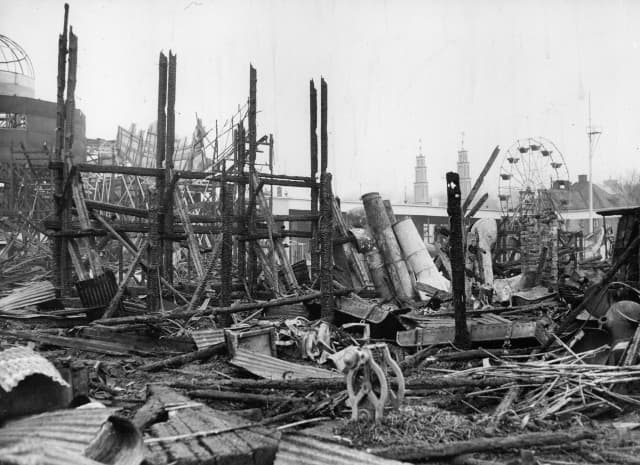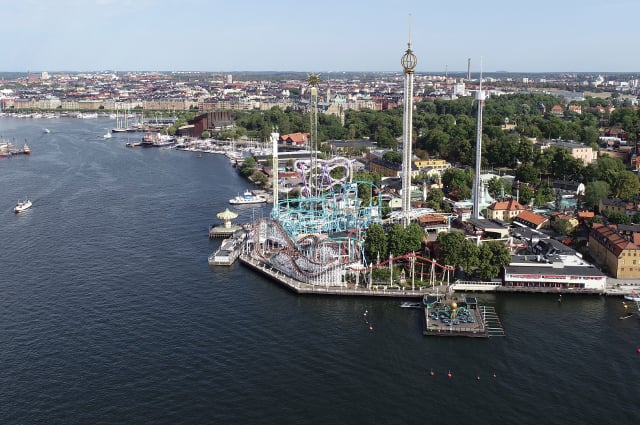Secret romance! Fire inferno! The story of Stockholm's Gröna Lund

In the 1930s, a devastating fire and a secretly kindled romance threatened to permanently engulf Gröna Lund Tivoli in Stockholm.
This article was written for Members of The Local. Read more about membership here.
Today, Gröna Lund Tivoli, located on Djurgården island in Stockholm, is Sweden's oldest amusement park, attracting some 1.5 million visitors each year. But on March 22nd and 23rd, 1935, the future of the already historic attraction was put in jeopardy when it was almost completely destroyed by fire.
Opened in 1883 as a small venue for "carousels and entertainment," Gröna Lund was by 1935 well on its way to becoming a truly modern amusement park. Influenced by American and British amusement parks, it had been undergoing major transformations since the 1920s. With new land acquisitions, the park began to take over more prime real estate on Djurgården. As new facilities were built and older buildings were upgraded or replaced, careful attention was given to architectural design and functionality.
Most importantly, at least from the visitors' perspective, the sedate carousels and entertainments of yesteryear were beginning to take a back seat to larger-scale performances by well-known entertainers, themed attractions, and modern American- and British-style rides, including a roller coaster and a Ferris wheel. In the early 1930s, some of the most popular new additions were the open-air dances with live jazz music, the German-themed Tyrol restaurant, opened in 1933, and Gröna Lund's first "dark ride", Skräckexpressen (The Horror Express), which was built in 1932.
More history articles on The Local
- The migration crisis that divided Sweden and made it a better country
- The immigrants you've probably never heard of who made Swedish history
- Read this and you may like Systembolaget a whole lot better

Gröna Lund today, located on the edge of the Djurgården island in central Stockholm. Photo: Fredrik Sandberg/TT
The modernizations were not only good for business, they were also essential for Gröna Lund's survival, especially after 1923, when a competing amusement park, Nöjesfältet, opened quite literally next door. From its start, Nöjesfältet was larger and more cutting-edge. It had the first roller coaster in Stockholm and was ahead of Gröna Lund with rides like bumper cars and a more extensive range of attractions and events.
For more than a decade, Gröna Lund's owners had worked hard to get and maintain an edge over the competition. By 1935, the park seemed to be holding its own, and was attracting a more diverse crowd than Nöjesfältet. It had also surpassed its competitor in sophistication by shedding its somewhat makeshift and temporary appearance of earlier years – a characteristic that still defined Nöjesfältet.
READ ALSO:
- Why do the Swedes take such long summer holidays?
- 10 telltale signs you've gone native in Sweden
- How to avoid being ripped off when you're renting in Sweden
Despite its grander appearance, many of Gröna Lund's rides and buildings were still constructed of wood, and this proved to be its proverbial Achilles' Heel when on the night of March 22nd, a fire started in a workshop. Spreading rapidly, it devastated most of the new area of the park, where many of the modern rides, including Skräckexpressen and the roller coaster, were completely or mostly destroyed by the following day.
"The heat from the fire was so intense that the large steel beams on the Ferris wheel bowed and the paint flaked away from the open-air dance floor wrapped in a steam cloud," according to a history on the official website of Gröna Lund.
From our modern vantage point, we of course know that the destruction did not mark the end for Gröna Lund. In fact, it instead demonstrated the incredible resilience of its owner, Gustav Nilsson, who managed to have several of the rides rebuilt – including Skräckexpressen, which was renamed Blå Tåget – by the end of the summer, as well as of the steadfast loyalty of its visitors.
While the competition between the rebuilt Gröna Lund and Nöjesfältet continued, a fire of another kind was being kindled which, though controversial, would benefit Gröna Lund in the long term.
In 1940, both Gustav Nilsson and the owner of Nöjesfältet, Johan Lindgren, died. Not long after, Nilsson's daughter Ninni and Lindgren's son John went public with their romance, which they had kept secret during their fathers' lifetimes, and ultimately married in 1942. Together, they ran Nöjesfältet until it closed in 1957, and then Gröna Lund until their son, John Lindgren Jr took over as CEO in 1981.
Victoria Martínez is an American historical researcher, writer and author of three historical non-fiction books. She lives in Småland county, Sweden, with her Spanish husband and their two children.
Comments
See Also
This article was written for Members of The Local. Read more about membership here.
Today, Gröna Lund Tivoli, located on Djurgården island in Stockholm, is Sweden's oldest amusement park, attracting some 1.5 million visitors each year. But on March 22nd and 23rd, 1935, the future of the already historic attraction was put in jeopardy when it was almost completely destroyed by fire.
Opened in 1883 as a small venue for "carousels and entertainment," Gröna Lund was by 1935 well on its way to becoming a truly modern amusement park. Influenced by American and British amusement parks, it had been undergoing major transformations since the 1920s. With new land acquisitions, the park began to take over more prime real estate on Djurgården. As new facilities were built and older buildings were upgraded or replaced, careful attention was given to architectural design and functionality.
Most importantly, at least from the visitors' perspective, the sedate carousels and entertainments of yesteryear were beginning to take a back seat to larger-scale performances by well-known entertainers, themed attractions, and modern American- and British-style rides, including a roller coaster and a Ferris wheel. In the early 1930s, some of the most popular new additions were the open-air dances with live jazz music, the German-themed Tyrol restaurant, opened in 1933, and Gröna Lund's first "dark ride", Skräckexpressen (The Horror Express), which was built in 1932.
More history articles on The Local
- The migration crisis that divided Sweden and made it a better country
- The immigrants you've probably never heard of who made Swedish history
- Read this and you may like Systembolaget a whole lot better

Gröna Lund today, located on the edge of the Djurgården island in central Stockholm. Photo: Fredrik Sandberg/TT
The modernizations were not only good for business, they were also essential for Gröna Lund's survival, especially after 1923, when a competing amusement park, Nöjesfältet, opened quite literally next door. From its start, Nöjesfältet was larger and more cutting-edge. It had the first roller coaster in Stockholm and was ahead of Gröna Lund with rides like bumper cars and a more extensive range of attractions and events.
For more than a decade, Gröna Lund's owners had worked hard to get and maintain an edge over the competition. By 1935, the park seemed to be holding its own, and was attracting a more diverse crowd than Nöjesfältet. It had also surpassed its competitor in sophistication by shedding its somewhat makeshift and temporary appearance of earlier years – a characteristic that still defined Nöjesfältet.
READ ALSO:
- Why do the Swedes take such long summer holidays?
- 10 telltale signs you've gone native in Sweden
- How to avoid being ripped off when you're renting in Sweden
Despite its grander appearance, many of Gröna Lund's rides and buildings were still constructed of wood, and this proved to be its proverbial Achilles' Heel when on the night of March 22nd, a fire started in a workshop. Spreading rapidly, it devastated most of the new area of the park, where many of the modern rides, including Skräckexpressen and the roller coaster, were completely or mostly destroyed by the following day.
"The heat from the fire was so intense that the large steel beams on the Ferris wheel bowed and the paint flaked away from the open-air dance floor wrapped in a steam cloud," according to a history on the official website of Gröna Lund.
From our modern vantage point, we of course know that the destruction did not mark the end for Gröna Lund. In fact, it instead demonstrated the incredible resilience of its owner, Gustav Nilsson, who managed to have several of the rides rebuilt – including Skräckexpressen, which was renamed Blå Tåget – by the end of the summer, as well as of the steadfast loyalty of its visitors.
While the competition between the rebuilt Gröna Lund and Nöjesfältet continued, a fire of another kind was being kindled which, though controversial, would benefit Gröna Lund in the long term.
In 1940, both Gustav Nilsson and the owner of Nöjesfältet, Johan Lindgren, died. Not long after, Nilsson's daughter Ninni and Lindgren's son John went public with their romance, which they had kept secret during their fathers' lifetimes, and ultimately married in 1942. Together, they ran Nöjesfältet until it closed in 1957, and then Gröna Lund until their son, John Lindgren Jr took over as CEO in 1981.
Victoria Martínez is an American historical researcher, writer and author of three historical non-fiction books. She lives in Småland county, Sweden, with her Spanish husband and their two children.
Join the conversation in our comments section below. Share your own views and experience and if you have a question or suggestion for our journalists then email us at [email protected].
Please keep comments civil, constructive and on topic – and make sure to read our terms of use before getting involved.
Please log in here to leave a comment.